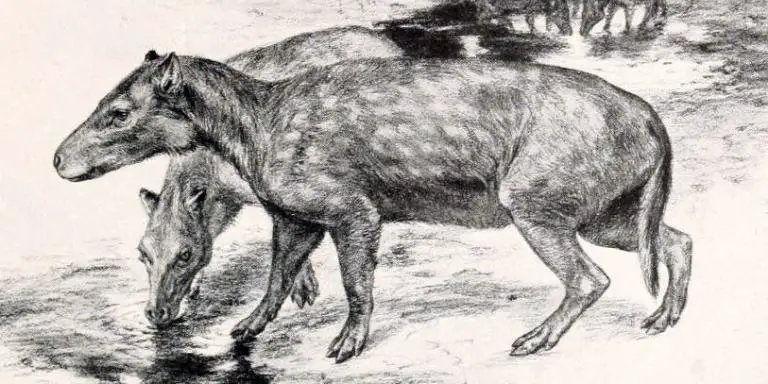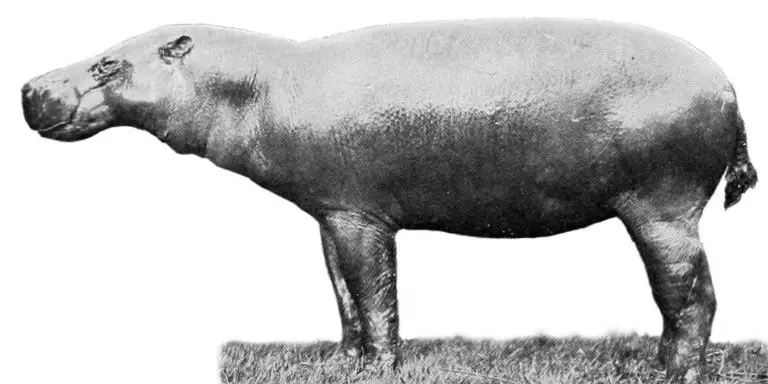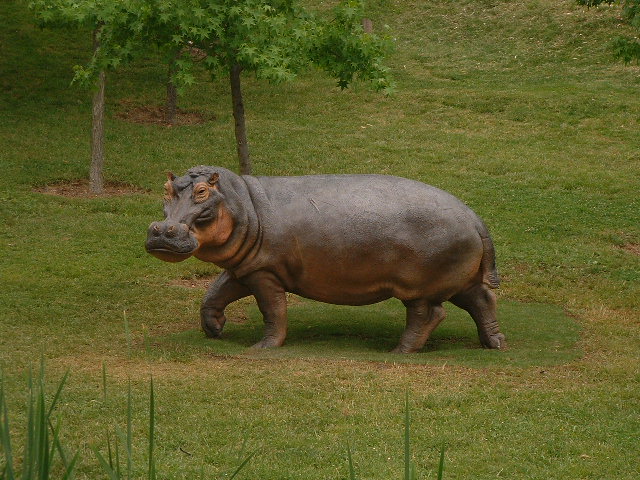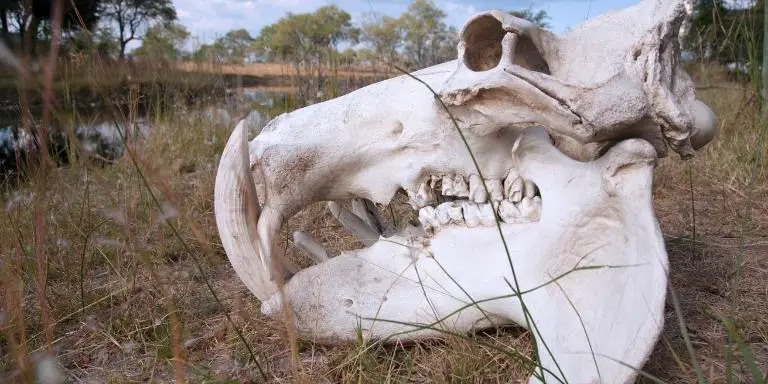Hippopotamus are curious animals. Many of their organs, such as teeth and skin, have raised important questions about their history among scientists. The evolution of their teeth and skin are very different from other mammals. The skin is watery, just like the whales. In fact, whales are the closest living relatives of a hippo.
Many discoveries in modern times are disclosing new stories on hippo ancestors. Their family tree is yet to be built, and scientists are looking for the missing pieces in the puzzle.
The latest discovery in 2015 proved that their ancestors lived about 28 million years ago and, surprisingly, were just as big as sheep.

Hippopotamus Taxonomy
A hippo is an animal with many names. The name hippopotamus is Greek and means “river horse”. People call them Common, River, or Nile Hippos.
In Africa, they’re commonly known as river cows. Several African tribes have different names for the animal. These names are ancient, and each name carries a particular history with them.
The Masai tribe calls them “Olmakau,” and the Somalis call them “Jir”. Various nations also have other names for the animal, such as the Germans call it a “Nile horse”.
Scientific Classification
The scientific name for the common hippopotamus is Hippopotamus amphibious.
The pygmy hippos’ scientific name is Choeropsis liberiensis.
Both of them belong to the mammalian class in the Artiodactyla order. Animals in this order are known to have an even number of toes or hooves.
The Life Cycle of a Hippo

Hippopotamuses live in groups of 10 to 30. Each group has a prime male. He mates with the females of his group.
Female hippos have a gestation of about 17 months. In the wet season, a single healthy calf is born. The baby is given birth underwater and has to swim upward to breathe. It lives on its mother’s milk initially and starts foraging for grass after about three weeks.
The mother has looked after her baby for about three years. After that, the calf is on its own. Male calves become adults at 6 or 7 and can mate afterward. In contrast, females become adults at 5.

Physical Features of Hippopotamus
The hippopotamus has a round-shaped body, a massive head, a short tail, four stumpy legs, and an even number of hooves on each foot. The barrel-shaped creature can grow up to 11.5 feet long and 5 feet tall.
The male hippos are larger than the females. They weigh up to 1500 kilograms. In comparison, the females grow up to 13500 to 1400 kilograms.
They have a massive mouth that can open up to 180 degrees. They also have long canine teeth called tusks. The male tusks are longer than that of females and can exceed the length of 12 inches.
Hippo skin is watery and nearly 2 inches or 5 centimeters thick. They look purple-brown or slate-grey in color. The skin is practically hairless. The long face with small eyes, nostrils, and ears is well situated on the top of the head. It helps them to be in the water longer.
Hippos also have a lot in common with aquatic mammals. For example, they have dense bones, and their muscles provide good propulsion through the water. Well-developed muscles help them construct a way to the lungs and provide necessary oxygen. It is a feature that is also common to whales.
First Discovery

The earliest hippos were discovered at the rock beds of Lokon Hill in Kenya. A team of paleontologists led by Fabrice Lihoreau from the University of Montpelier in France is the ones to discover this.
Anthracotherium is the name of the prehistoric relative of hippopotami. They belong to the family Anthracotheriidae. They used to live in this world nearly 28 million years ago. So it is confirmed that hippos have been on this planet for almost 28 million years. This unique discovery was confirmed by detecting a pattern found in the teeth of the fossil.
Hippos moved through the world during the Oligocene period. Their numbers were distributed in Europe, Asia, and North America to some extent. But their family members died out in the late Miocene. Scientists think this is due to scarcity of food and more competition.
However, since the hippos and whales are related, their common ancestor was found to be more ancient than the Anthracotherium. These are known as Elomeryx, and they lived in the world about 33.9 million years ago.

They also belong to the Artiodactyla family. Scientists have declared that the Elomeryx was in Asia in the middle Eocene age and Europe during the latest Eocene period. Then they moved to North America during the beginning of the early Oligocene.
Introduction to Hippo Ancestors
The hippopotami have a long chain of historical relatives. Their forefathers successfully ruled the earth for millions of years. Many of them traveled through the world. This is why scientists excavated the fossils all over Asia, Africa, and North America.
The family chain even broke into many subfamilies. It created many other modern-day animals such as horses, orcas, dolphins, the great giant whales, and many more.
New discoveries are continuously changing the way we view the world. The hippo ancestry line is no different. Many things are rumored about their history, but not all are true. But is it true that hippos evolved from whales? No, they didn’t. Instead, they both have a common ancestor.
Elomeryx is the common ancestor of hippopotamus and whales. It was a very widespread genus. This semi-aquatic mammal lives in Asia and has wide feet for walking in muddy environments. Their staple food was water plants.
But how come the aquatic whale and the semi-aquatic hippo have common ancestors? It is exciting to know that whales once had legs and walked around the earth. It seems complicated for us to believe.
But it is the truth. The typical ancestral chain of the two different species was divided into two major groups: Whippomorpha and Cetacea. This happened nearly 60 million years ago.
Hippopotamus Evolutionary History
Hippos are included within the clade – Hippopotamoidea. It consists of both Anthracotheres and Anthracotheriidae. These anthracotheres first came into being in the Paleogene age.

However, how and why exactly the evolutions occurred from the earliest Elomeryx to modern-day hippopotamuses is still very unclear. Many pieces in the middle are still missing, and scientists are working on finding those. However, the Asian semi-aquatic mammal Elomeryx first came about 33.9 million years ago.
The Anthracotheriidae family had a lot of members that existed for a long time. Such as the Anthracotheriums. They first existed nearly 28 million years ago in Asia. They were pig-like animals that were at their peak during the Eocene epic.
However, their decline started during the end of the Miocene period. The Merycopotamus is the last known genus of the group. It lasted a range from 11.5 to 5.3 million years ago. Their extinction might be caused by climate change or by the vast competition presented by their similar species. Scientists are not a hundred percent sure of the causes, though.
After the decline of Anthracotheriums, several more species took their place and filled up the blank positions of the hippos’ historical chain. Such as the Morotochoerus that existed from about 22.4 to 11.6 million years ago.
However, some scientists disagree with the fact that the Morotochoerus is a member of the hippopotamus family. Relatively more of them agree that Kenyapotamus is one of the confirmed members. They existed during the middle Miocene from about 11.6 to 9.5 million years ago.
They were followed by the genus Archaeopotamus which existed from nearly 11.6 to 3.6 million years ago. They all had a water cow shape and characteristics.
However, these old hippos were soon replaced by more modern groups during the end of the Miocene. One of the members of the modern genus is the Hexaprotodon. Their trace was found from Africa to Southern India, dating back to the late Pleistocene, about 15000 years ago.

More modern genera include the Hippopotamus gorgops that exceeded the size of today’s hippos. They used to grow up to 10,000 kilograms.

Hippos from Madagascar island are also included in this modern group. However, their size was so small that they looked like only a fraction of modern hippopotamuses. But all of them are now extinct, and only two species the common and the pygmy hippos remain in the world.
Lastly, the pygmy hippos are the last living creatures of their genus. They were divided from the common chain of relations during the Miocene period. Currently, they are living their last days on the verge of extinction in this cruel world.
The Fossilized Skulls
The teeth of hippo fossils disclose a lot about the creature’s past. The skull of their forefathers, too, helped us with a handful of knowledge. It is most curious to disclose the history hidden inside old bones found underground.

The modern skulls, however, are enormous. They are nearly 2 feet long and 1.5 feet wide. The massive specimens are rounded in shape, have menacing teeth pointing outside, and deep abysmal eye sockets.

The Hexaprotodon is such an animal, the fossilized skull of which was excavated. They were the size of a pygmy hippopotamus and lived during the Pliocene and Pleistocene period.
They were Asian, and their remains have been excavated throughout different places of Asia, such as India, Srilanka, Indonesia, and Nepal.
Frequently Asked Questions
Did hippos live with dinosaurs?
A recent excavation in Poland has begun a new era of fossil knowledge. The 5 meters long and 9 tonnes weighing giant reptile has been dug out of the ground. The specimens date back to 300 million years ago.
Scientists are saying they were closer to modern mammals such as hippopotami. They had a similar bent body structure and large tusks. They were the size of an African elephant and were direct rivals to dinosaurs.
Are Crocodiles older than hippos?
The crocodiles are one of the oldest living creatures. They have survived the change in the world since the time of the dinosaurs.
The oldest hippo dates back to 33.9 million years ago. Whereas the oldest crocodile dates back to 205 to 223 million years ago. So the crocodiles are definitely older than hippos.
Crocs are one of the most successful species of all time. They even managed to outlive the dinosaurs.
Conclusion
The parental history of the hippopotamus dates back millions of years. They have survived the ups and downs of the environment for so long. Their species are now mainly the continent of Africa.
But all of them are on the verge of extinction due to excessive poaching and habitat loss. If proper steps are not taken quickly, no sign of them will be left in the future.
